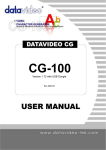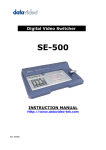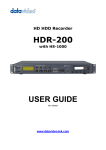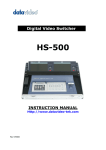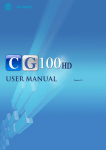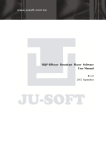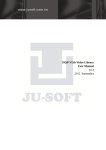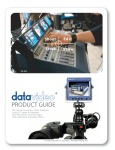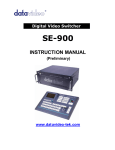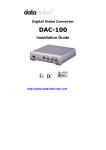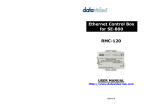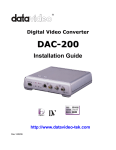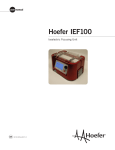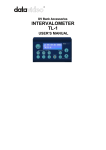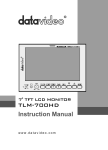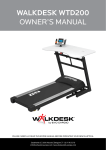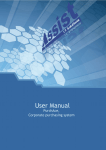Download Datavideo CG-100 Instruction Manual
Transcript
CG-100 Version 1.63 with USB Dongle 1 Warnings and Precautions If you have purchased CG-100 software with a Blackmagic Design DeckLink Card please observe the precautions supplied when installing this DeckLink card. It is also advisable to read any precautionary notes supplied with your computer when installing new hardware and software. When installing new software on to a Windows XP or Vista machine it is advisable to first create a System Restore Point, this will provide a working machine to go back to, should anything go wrong during installation. Details of how to create a System Restore Point can be found in your PC instruction manual or from the Microsoft Website. 2 Table of Contents Warnings and Precautions ..................................................... Packing List ............................................................................ Introduction ............................................................................ Product Overview ................................................................... Features ................................................................................. Minimum requirements ........................................................... QuickTime Recommendations ............................................... CG-100 Interface ................................................................... CG-100 Set Up ...................................................................... TV Standard selection ................................................ The difference between NTSC and PAL .................... Display modes 4:3 and 16:9 ...................................... Setting the Video Standard .................................................... Setting Margins ...................................................................... Left to right reading ................................................................ Synchronise CG output and Play function .............................. CG Output with no video input ............................................... External Key ........................................................................... Enable App Button (Logo Generator) ..................................... Language Setting ................................................................... GPI Trigger ............................................................................ Tools Effects .......................................................................... Files ....................................................................................... Pages ..................................................................................... Objects ................................................................................... Layout and animation tools .................................................... Parameter panels ................................................................... Layout editing ......................................................................... Text editing ............................................................................ 1 Text button on the tool bar ...................................... 2 Drag marks on a text object .................................... 3 Moving a text object ................................................ 4 Fine tuning text object position ................................ 5 Resize a text object ................................................ 6 Adjusting gaps between letters (Kerning) ................ 7 Rotating a text object .............................................. 8 Content of text objects ............................................ 9 Multi-line text objects .............................................. 10 Save text styles ..................................................... 11 Apply a style ......................................................... 12 Text parameter setting .......................................... 3 2 6 6 7 8 9 10 11 12 12 12 13 14 14 15 16 17 18 19 20 21 24 24 25 28 29 30 32 32 32 33 33 34 34 34 35 36 38 41 43 43 Text Parameters ........................................................ 13 Vertical text object ................................................ Default width of a letter .............................................. 14 Import text from a file ............................................ Inserting a graphic bar or line ................................................. Inserting a Rectangle or Ellipse .............................................. Inserting an image .................................................................. Setting image transparency .................................................... Select a colour to be transparent ........................................... Extra editing tools .................................................................. 1 Background Button ................................................. 2 Grid Button .............................................................. 3 Group Button .......................................................... 4 Top / Bottom (layers) .............................................. 5 Delete ..................................................................... 6 Undo / Redo ............................................................ Group move / zoom ................................................................ Group Copy / Cut / Delete ...................................................... Animation Editing ................................................................... Setting up an Animation box .................................................. Add a [Display] Animation ...................................................... Add a [Wipe] Animation .......................................................... Add a [Push] Animation .......................................................... [Wipe] with reserve last screen .............................................. [Push] with reserve last screen .............................................. Add a [Fade] animation .......................................................... Roll & Crawl ........................................................................... Roll a list .................................................................................. Adjust the size of a roll object ................................................. Adjust the size of a crawl object ............................................. Live CG editing ...................................................................... Live status panel .................................................................... Quick edit function .................................................................. Modify the text ........................................................... Page list ................................................................................. Select a page ............................................................. Delete a page ............................................................ Duplicate a page ........................................................ Insert a page .............................................................. The effect of reserve last screen ............................................ Clean last screen ................................................................... Clipboard ................................................................................ Copy to the clipboard ................................................. Lock / Un-Lock the clipboards .................................... 4 44 46 46 47 50 53 55 57 58 59 59 60 60 60 61 61 62 66 67 67 71 74 76 77 78 79 80 80 83 86 89 90 92 92 94 94 94 95 95 96 98 99 99 100 Paste from the clipboard ............................................ Logo ....................................................................................... Clock & Timer ........................................................................ Clock .......................................................................... Timer ......................................................................... Targa Sequences ................................................................... Transfer text to CG function ................................................... Functions ................................................................... Number tags for text objects ...................................... Application .......................................................................... Logo Generator .......................................................... Features of Logo Generator ....................................... System Buttons .......................................................... Logo Pages ............................................................... Setting up a sample page .......................................... Adding background CG-100 pages .......................... Adding a Logo or Bug ................................................ Adding a Targa Sequence ......................................... Add Crawl A / Crawl B ............................................... Commercial break ...................................................... Logo Page quick modification .................................... DL Renderer ......................................................................... Setting of DL Renderer .............................................. LiveStream – CG100 Bonus Utility ...................................... Hardware requirement ............................................... Purpose ..................................................................... How to use LiveStream................................................ Trouble shooting LiveStream ..................................... 100 101 103 103 104 106 108 108 110 112 112 112 115 116 117 118 119 119 120 122 122 125 126 127 127 127 128 132 Frequently Asked Questions ............................................... 133 CG-100 Registration .............................................................. 135 Sample Connection Diagram ................................................. 136 Service & Support .................................................................. 137 End User License Agreement ................................................ 138 5 Packing List 1. CG-100 software CD 2. CG-100 Security Dongle x1 2. CG-100 Installation Guide 3. CG-100 User Manual 4. BNC 1.8 m cable x2 5. Optional video card* Blackmagic Design DeckLink SDI PCIe card or Blackmagic Design DeckLink Studio PCIe card * Please consult your dealer to confirm if a card should be present. Introduction Thank you for purchasing the Datavideo CG-100. The CG-100 is the first CG software that uses the Blackmagic Design DeckLink series as a video output card. The CG-100 can be used as an accessory with Datavideo vision mixers like the SE-800 or SE-900, or as an individual unit. It is also the first Live CG software that has an SDI interface at an affordable price. You will be amazed by what you can do with this product. In order to get the maximum of this product, we recommend that you spend some time reading this manual carefully. 6 Product Overview SDI overlay offers the best, broadcast quality, CG solution in the industry today. However, it has always been beyond the budget of small studios and production houses – Datavideo CG-100 has now changed that! The CG-100 combines with a Blackmagic Design DeckLink Card to give you a live SDI CG overlay at an affordable price. It supports NTSC and PAL video standards and is able to generate graphics for either 16:9 or 4:3 aspect ratios. Pages can be composed, saved and combined with animation effects, to run as a sequence, or they can be displayed and edited live. CG-100 combines perfectly with the SE-800 / SE-900 mixers to give superb quality graphics / text / logo overlay on live production mixes. CG-100 can be used with any SDI or YUV input switchers (with the DeckLink SP, DeckLink Pro or DeckLink Extreme cards). It can also be used with the SE-800 / SE-900 via the SDI / CG overlay interfaces. 7 Features Image objects may be imported as graphics and stored as part of the page. Simple shapes (bars, ellipses and rectangles) are menu items and may be added to the page. Animation objects can Wipe, Push, and Fade in various directions at different speeds. Text can roll and crawl. Supports Windows Unicode for multi-language inputs Redo/Undo functions for quick testing of an additional effect. Live editing mode provides great flexibility to immediately alter one CG page while another CG page is live. Quick CG Text Editor allows navigation from page to page to quickly Stand-alone logo display function. Nine “clipboard” items can be stored and used in CG combinations on modify text different pages and files. Group function makes CG combinations easy to edit. SDI available. (DeckLink SDI or Studio PCIe cards) YUV available. (DeckLink SP, Pro, or Extreme) External Key output (DeckLink Pro only) Automatically create multiple CG pages from a text file. Time & date display TARGA sequence playback GPI trigger animation. Can select different operation mode, “Logo Generator” Plus bonus Live Streaming software 8 Minimum Requirements CPU: Intel Pentium 4 (2.0 GHz) or higher Operating System: Microsoft Windows XP Professional with SP2 or higher or Microsoft Windows Vista Ultimate with SP1 System RAM: 2GB or higher for Windows XP or 4GB or higher for Windows Vista VGA resolution: 16-bit colour (32-bit recommended) VGA, XGA or higher Required Free HDD Space: 100 MB (for CG-100 & DeckLink Driver) Compatible PCIe cards: Blackmagic Design DeckLink SDI card or Blackmagic Design DeckLink Studio Card. USB Port: Computer needs 1 free USB 2.0 port for the CG-100 Dongle NOTE: These system specifications may change, without notice, depending upon the card used. Please consult your dealer for the latest advice. For the latest information on Blackmagic Design Cards please visit: http://www.blackmagic-design.com/support/ 9 QuickTime Recommendations We have found that QuickTime™ 6.3 or later is fully compatible with CG-100 cards and drivers. If upgrading to the latest version of QuickTime™, you will need to re-install the latest DeckLink drivers to regain full functionality of your DeckLink card. Additional information and downloads can be found using: www.apple.com/quicktime/ For the latest information on Blackmagic Design Cards please visit: http://www.blackmagic-design.com/support/ 10 CG-100 Interface 1). Save File 11). Copy a page 2). New File 12). Delete a page 3). Open File 13). Logo On/Off 4) .Setup 14). Clock / Timer 5). Margin setting 15). Targa sequence 6). Page Info 16). Extra Editing tools 7). Clip Board 17). Graphics tools 8). Animation tools 18). Editing tools 9). Playback by sequence 19). Text and Image Editing window 10). Insert an empty page These are all the basic function descriptions. For more detailed information and application, please read through the rest of this CG-100 user manual. 11 CG-100 Set Up TV standard selection CG-100 can be set for either NTSC or PAL. It can also be set as either 4:3 or 16:9. When choosing NTSC, the TV screen resolution is 720 x 486 pixels. When choosing PAL, the resolution will become 720 x 576 pixels. However, on the PC side, there is no difference between PAL and NTSC, the screen W/H is just 4:3 or 16:9. When using the CG-100, you must keep in mind that the pixels on the PC screen are not the same as on a TV. The following picture is how CG-100 looks when 16:9 is selected. Difference between NTSC and PAL Although the resolutions of NTSC (720x486) and PAL (720x576) are different, the ratio of their widths and heights are the same. If we use the concept of pixel co-ordinates (X and Y). Let us say that the Y co-ordinate of title A is 243. In NTSC the height of title A is in the middle, as NTSC is 486 high. However, for PAL title A would appear in a higher position, as the height of PAL is 576. See the example on the next page. Now, if title B is placed at the bottom of a PAL screen, it would be lower, and possibly outside the visible screen area when it is changed to the NTSC mode. 12 Title A in NTSC mode is in the middle Title A is higher when the mode is changed to PAL Title B is out of the Safety Margin in NTSC mode Title B is in the normal screen position in PAL mode Display mode 4:3 or 16:9 Setting CG-100 mode from 4:3 to 16:9 will not change the resolution of the PC monitor. However, transferring an existing circle from 4:3 to 16:9, will change its shape from a round circle to an ellipse. Please see the examples as below. Top is circle in 4:3 Bottom is ellipse in 4:3 Top is ellipse in 16:9 Bottom is circle in 16:9 13 Setting the Video Standard Go to SET UP, Click on the required video standard. The CG-100 Application needs to be re-started if changes have been made. Setting Margins Type the pixels to be deducted for horizontal and vertical margins 14 Right to left reading CG-100 enables typing for Left to Right and Right to Left. For Right to Left reading you need to tick the check box “Right to left reading” Be aware that you need to select appropriate fonts, especially for Hebrew or Arabic, to have the editing direction from right to left. For example the question mark “?” will be placed at the left side while choosing Hebrew fonts. 15 Synchronize CG output, PLAY function When this selection has been ticked, the CG output will be cleared when clicking stop. i.e. it does not appear on the video out. This function needs to be enabled when using live mode. 16 CG output with no video input Anti-aliasing CG output when video stop input - This option is used if there is no video being input, and you want to output the computer graphics and text only on a black background just for presentation etc. Remember: tick the check box: “Anti-aliasing CG output when video stop input” to ensure a good quality presentation output. Without Video Input However, if there is video being input, do not tick the check box. 17 External Key This function only works with Decklink Pro card only.Tick the check box: “External Key (DeckLink Pro only)” So Alpha Key output for Live Video and CG output can be merged externally in another device /mixer. 18 Enable [App] button To enable a special logo generator plug-in application of CG-100, please go to SETUP window and tick “Enable [App] button”. If you do not want this plug in, remove the tick so that the App. Button box is empty. 19 Language setting Select the language setting for your user interface. The software needs to be restarted after selecting your chosen language. 20 GPI Trigger You can set a GPI to trigger the Animation objects like wipe, push, fade etc in CG-100. The following steps are used to set up a “GPI trigger” Step1 Set “Wait until keyboard” for the “Prior_Wait” and “Post_Wait” of all animation objects. Please note that between 2 animation objects, you do not have to set double “Wait until keyboard”. For example, Animation A is set “Wait” for the “Post_Wait”. If its follower: Animation B is also set to “Wait” for the Prior_Wait”, there will be 2 “Wait” in between. The user would have to send 2 GPI triggers to continue the motion. It is not a good setting and it tends to confuse the operator. Just remove one “Wait” and set “0 second” instead. 21 Step2. Go to [Setup] dialog in [GPI Trigger], select from COM1 to COM4 to choose one of the Serial Port DSR signal lines. Connect the hardware of GPI (General Purpose Interface) to the selected COM port. Step3. Tick Active High, this means when the DSR signal is High Voltage, the next animation will be triggered. Off Active High, means when the DSR signal is Low Voltage, the next animation will be triggered. Step4 Method1 If your GPI is a switcher, the easiest way to connect GPI to COM port is to connect the ON/OFF point (line) directly to the 4th pin (DTR output) and the 6th pin (DSR input) of 9-pin COM Port socket. In this case, please go to [Setup] and tick [Active High]. Therefore, when GPI switches ON, the positive Voltage from DTR output goes to the DSR and it becomes High Voltage, so that it can trigger the animation objects set as “Wait until keyboard” in CG-100. The connection cable of the GPI can be up to 10 meters. 22 Step4 Method2 If your GPI is a photo transistor, please note the direction of electric current is from the 4th pin (DTR output) of COM Port 9-pin socket to the 6th pin (DSR input). When the ON/OFF points of the photo transistor are connected in an opposite way, the GPI will not function properly. Step4 Method3 If one of the GPI ON/OFF points has to be grounded, then you have to place a 1 kO resistor between the 4th pin (DTR output) and the 6th pin (DSR input) of the COM PORT 9-pin socket. Meanwhile, the GPI ON/OFF points should be connected to the 6th pin (DSR input) and the 5th pin (GND). In this case, the Active High in [Setup] dialog should be “OFF” for Active Low setting. 23 Tools, Effects Files The file format for CG-100 is *.vcg. Click the [File] button to display the “File” drop down menu options. Alternatively, you can also use the following buttons to open, save, or create a new *.vcg file. 24 Pages Each *.vcg file can include many “Pages”. Every page may contain 3 kinds of objects: text, graphics and animations. All the pages in a *.vcg file will be shown to the right side of the page area. The pages will be created in the selected aspect ratio, either 4:3 or 16:9. The following image explains how the pages of a .vcg file will appear in preview form on the right side of the screen. 25 The current page is the sixth page and there are six pages in total. 26 There is a different layout showing the page information. It is on the top of the page icon. When a new CG file is created, 4 blank pages will automatically appear in the Page Area. Click to select a page. You will see a Red border around the page. The highlighted page is the page that is currently in use. You can edit pages by inserting, deleting, copying or pasting the pages into the clipboard. For swapping the pages, just click the target page and drag it to the destination. (Note: the page will not be actually moved until you drag it over half a page.) 27 Objects There is a Red Border around the page that is currently in use, i.e. the one in the working area. There are 3 CG objects in the working area: 2 text objects and a graphic bar. The 1st text object = “CG-100” The 2nd text object = “High quality,” The 1st graphic = a blue bar You can treat CG editing as sticking stickers on paper. For example, 3 CG objects are just like 3 stickers. Look below to see how easy it is. Add a new sticker → Add a new CG object Remove the sticker → Delete the CG object Move the sticker → Change the position of the CG object Adjust the order of the stickers → Alter the sequence of the CG objects Resize the CG object Edit the CG text 28 Layout and Animation Tools CG-100 offers the following editing tools: In 4:3 mode, “Editing” Tool bar and “Animations” Tool bar are as below: In 16:9 mode, “Editing” Tool bar and “Animations” Tool bar are as below: 29 Parameter Panels The CG-100 provides 5 editing tool-buttons for you to add Text, Bars, Rectangles, Ellipses and Images. You can go to the Parameter Panel to set the colours of text, the precise positions etc. Please see the following examples: Text Parameter Panel (1) Text Parameter Panel (2) 30 Text Parameter Panel (3) Graphic Parameter Panel Image Parameter Panel Animation List The CG-100 provides 4 kinds of animations. You can click on the buttons to insert a Display, Wipe, Push or Fade effect. After inserting an animation effect, it can be edited on the Animation List Editing Panel. 31 Layout Editing The CG-100 Layout is composed of 5 elements including text, graphic bars, rectangles, ellipses and images. To edit the CG Layout, you should do the following: Press one of the buttons on the tool bar to insert a new object. Drag the object to the required position and if necessary, resize it. Set parameters on the Parameters Panels. If necessary, you can cut, delete, and adjust the sequences among objects. Text Editing This is the way to insert a text object: (1).Click Text button on the tool bar A text object will be created in the working area. 32 Normally, the text content is as same as the previous one. Otherwise, a default “VCG Sample” will be used for the first text insertion. (2). Drag marks on a text object The selected text object will be surrounded by 4 marks: (3). Moving a text object Place the cursor on the text object, but do not put the cursor on any of the 4 marks. Press and hold the left button. This will make the cursor become a Drag Symbol, which means the text object is selected and ready for editing. Hold the left button down and move the mouse, the text object will follow the mouse. Once the text is in the right place, release the left button. The meshed surface allows you to see other objects through the selected one while it is moving over them. 33 (4). Fine tuning Text Object position It is hard to move just a pixel or two by using the object drag function. In this case, you can press the keyboard arrow buttons. Every single press moves the text object one pixel in the chosen direction. Note: While typing, the arrow buttons are for moving the cursor. If you want to use the arrow buttons for moving the text object, you have to use them immediately after dragging the object to the approximate position. (5). Resize a Text Object (6). Adjusting the Gaps between letters (Kerning) Press dual-squares and move the mouse horizontally – Right to increase and Left to decrease. 34 (7). Rotating a Text Object To rotate the object left click on the circle, hold the left button down and move the mouse vertically. 35 (8). Content of Text Objects You can type the content of the text objects in the typing area under the working area. Change the content here in the typing area 36 A text object literally means a single-line. When you’ve finished typing, press [enter] to update the target text object. The below example shows how to change “CG-100” into “CG String Sample”. Clicking the [Update] button, this will apply the alterations to the text object. Part of the object may now be outside of the working area. Select the object and reposition it. To avoid this situation, please set the alignment properly before updating the text object. 37 The three kinds of alignment will affect the position when the latter text is longer or shorter than the original text. The text object will be updated as soon as you click [Update]. (9). Multi-line Text Objects You can create a multi-line text object, just like a paragraph. Tick [Multi-line] to enable this function. 38 With Multi-line selected the typing area will be extended, so that you can type a whole paragraph. CG_100 auto updates the text when the text changes. Note: When typing multiple lines, the [Enter] key move the cursor to the next line and update data. 39 The following is the result of text changes: 40 (10). Save Text Styles When you create a text object and want to save its style as a sample, just click the Style button to open the [Text Styles] panel. Step1: Colours, fonts, outline and thickness can be stored in the “Style Panel”. Click this to open the “Style Panel”. Step2: Click to select a place for storing the style. 41 Step3: Back to select the text line on the working area. Step4: Click this button Step5: Save to store the text style in the selected place. all styles into a file. 42 (11). Apply a Style First click to select the text object. Then double click one of the styles on the panel. The style will be applied. (12). Text Parameter Setting You can set the parameters in the Text Parameter Panel. Click [X] to close the window. The text parameter Panel comes back immediately. 43 Text parameters: Font Any True Type fonts already loaded to the PC, click the button to select from other fonts. Width The width of letters. Press left button, move the mouse horizontally. Height The height of letters. Press left button, move vertically. Pos-X X field of the text object. Press left button, move horizontally. Pos-Y Y field of the text object. Press left button, move vertically. Color-I The fill colour. Click the colour to select other colours. Alpha-I The opacity of the fill. Press left button, move horizontally. Rotate Rotate the text object. Press left button, move horizontally. Char Gap Gaps between letters. Press left button, move horizontally. Color-O The colour of the outline. Click the colour to select other colours. Alpha-O The opacity of the outline. Press left button, move horizontally. Outline The border of the text object. Press left button, move horizontally. Line space Only for Multi-line text objects. Press left button, move horizontally. Align left /Top Set the Axis of the text object (the cross mark) to the left/top. Words add from left to right, top to the bottom. Align Center Set the Axis of the text object (the cross mark) in the center. Words go from left to right, top to bottom. Align Right /Bottom Set the Axis of the text object (the cross mark) in the center. Words go from left to right, top to bottom. Bold Tick to make the fonts bold-faced. Italic Tick to make the fonts Italic. 44 You can set the text object parameters in the relative dialog boxes. Tick to select bold-faced fonts or choose from three options of text alignment. Other parameters can be set by depressing the left mouse button and moving horizontally. For example, if you want to set the transparency of a text object, follow the steps below: Place the cursor on the number box of “Alpha-I” item. Press left mouse button to change the shape of the cursor [two-side arrows] Press left button and move the mouse horizontally to change the level of transparency. You can see the target object changes its opacity immediately on the working area. 45 (13). Vertical Text Object For some Asian languages, sometimes text goes vertically. If you want a vertical text object, follow the steps below, Open [Font] dialog box. Select the font whose name starts with @. Set the parameter of [Rotate] to 270°. Note: Double click the number box of the [Rotate] item. The program will set the default angles which are as below: For fonts whose name starts with @, the default angle is 270°. For all other fonts the default angle is 0°. Default width of a letter The default width of a letter for Windows PC is a half of its default height. If you want to return to its default setting, please double click the number boxes of [Width] or [Height] items. Double click [Width] item, the width will be 1/2 of its height. Double click [Height] item, the height will be 2 times its width. 46 (14). Import text from a text file If you need to use a large amount of text already prepared or text in foreign languages, you can import the text from a file. The CG-100 allows you to import text from a notepad *.txt file. Step1: Click this button 47 Step2: Create a default text object and select it. Step3: Open a text file. Highlight the required text. Step4: Click this button to output the text. 48 The result is just like below. 49 Inserting a Graphic Bar or a Line Click this button to insert a bar or a line. There are 2 square marks on both ends of a graphic bar/ line. You can hold on either side to alter the bar/ line. 50 The parameters of the graphic bar/ line can be set on the following panel. Bar Width The width of the graphic bar / line, press left button and move the mouse horizontally. Outline The thickness of its outline, press left button and move the mouse horizontally. Inner Colour The fill colour, go to a dialog for further settings. Outline Colour The outline colour, go to a dialog for further settings. Inner Alpha The opacity of the fill, press left button and move the mouse horizontally. Outline Alpha The opacity of the outline, press left button and move the mouse horizontally. 51 Many kinds of Graphic Bars/ Lines: 52 Inserting a Rectangle or an Ellipse Click this button to import a rectangle To move this rectangle, click the inner part then move it. To resize the rectangle, click the square on the bottom right and move it around. Click this button to import an ellipse. To move this ellipse, click the inner part then move it. To resize this ellipse, click the square on the bottom right then move it around. 53 Parameters Panel for rectangles and ellipses. Outline - the thickness of its outline, press left button and move the mouse horizontally Inner Colour - the fill colour, go to a dialog for further setting Outline Colour - the outline colour, go to a dialog for further setting Inner Alpha - the opacity of the fill, press left button and move the mouse horizontally Outline Alpha - the opacity of the outline, press left button and move the mouse horizontally Many Kinds of Ellipses and Rectangles: 54 Inserting an Image Step1: Click this button to insert an image object. Step2: Click “File” to select an image file. The image will be shown on the working area. 55 Step3: Click the inner part of the image to move the image. Step4: Press the square on the bottom right to resize the image. 56 Step5: The image selecting panel is as follows: Image File path Open Position Size Alpha Colour Key Key Colour [… ] - shows the path of the image file - to open a dialog box for image selection - the position of the image - the size of the image (pixel by pixel) - the opacity of the image - tick to enable colour key function. - to designate a colour for keying, which will become totally transparent. The transparency of an image When you set the transparency of an image, the setting is applied to the whole image. The levels of transparency are from 0 to 255. 0 is fully transparent while 255 is fully opaque. If the image format is targa 32 bit, then the transparency set here will multiply by the files original alpha. (Note: Some applications such as Adobe Photoshop allow users to create targa 32bit image.) A Targa Alpha=255 57 Alpha=85 Select a colour to be transparent Step1: Insert the bmp file. Tick [Colour Key] Step2: Press the button a dropper. to turn the cursor into 58 Step3: Place the dropper over the colour that will be transparent. Click left button to select the colour. You can adjust the number to remove the background. Step4: The selected blue colour becomes transparent. Extra Editing Tools The CG-100 provides extra editing tools that make editing more convenient. (1). Background button The default background of the working area on the CG-100 is black. However, if a title is very dark or the outline has to be black, it cannot be seen clearly with the black background. So the [background] button allows you to change the background colour. When you click the button, the background will be changed from black, dark gray, gray, light gray to white. It goes around as a loop. 59 Please see the following examples: (2). Grid button The grid makes aligning objects much easier. When you click the [grid] button, it goes around as a loop from X? 5? 10. The [X] means the grid function is disabled. The [5] means the squares are 5x5 pixels. The [10] means the squares are 10x10 pixels. (3). Group button Click the [group] button to display the group menu with the following options. (4). Top/ Bottom (layers) The objects on the CG-100 working area are placed in the order they were created. The first insertion is on the bottom and the last one is on the top. Of course it doesn’t matter if there is no overlapping. However, if more than two objects overlap, the Top / Bottom button enables you to put the layers in the right order. Click to select an object on the working area. Then click the [Top / Bottom] button. Every click moves: The front object to the back The lower objects all move one layer forward. 60 (5). Delete Click [Delete] to delete a selected object. (6). Undo / Redo Cancels or retrieves the last applied effect or command; i.e. reverts to previous attributes. 61 Group Move/Zoom Click [Group Move/Zoom] button, There will be 2 boxes, the blue one and the red one. The red box, the source box, is to select the source object/s - usually more than one object. The blue box, the destination box, is to place and resize the result. If the red box is as big as the blue box, then the group of objects is just moved to another place. If the blue box is not equal to the red one, that means the group of objects will be moved and resized. To perform this function, you need to place the cursor on the squares on the source box or on the destination box as below, The following is a group of CG objects which include a water lily image, a green bar and a text object, “VCG Sample”. 62 If you want to enlarge the whole group, the steps are as follows: a.) Place the cursor on the top left side. Drag the red box to encompass the objects. b.) Drag the red FRAME to the top left side of the group of objects. c,) Place the cursor to the bottom right of the red box. Then drag to resize the box 63 f.) Then place the cursor to the top left side of the blue box. g.) Drag to move this blue box to the destination. h.) Put the cursor on the bottom right. Drag to resize the blue box. i.) Drag to resize the blue box. The size of this blue box represents how big the whole group will be. 64 j.) When all the adjustments are done, click the annulus to finish and display the result. The original group k.) You will see the whole group has been enlarged to the size of the blue box. The result after executing [Group Move/Zoom] If you want to undo this function, just click the [Group Move / Zoom] button again to revert to the original settings. 65 Group Copy / Cut / Delete After clicking the Group button, select one of the options: [Group Copy], [Group Cut] and [Group Delete]. These functions all create a blue and white outlined box on the working area. Place and resize the box to surround the target objects. Then you can copy, cut or delete the objects inside the box Unlike when cropping an image, the CG-100 will copy, cut or delete the entire object instead of a portion of it. So, when the blue and white box only surrounds a part of an object, the CG-100 will verify whether the center of the object is inside the box. If so, the object is selected. If not, it is not selected. Once the blue and white box is surrounding the target objects, click the annulus to start copy, cut or delete. Below is the result after doing cut/ delete The copy function allows you to copy the group of objects to the CG’s clipboard. There are 10 spaces to store them. If you want to retrieve the group objects, click the clipboards to paste the group in the original position on a page. 66 Animation Editing The CG-100 offers various animations such as Display, Wipe, Push, and Fade; also Roll and Crawl to scroll text across the screen or up the screen. Setting up an Animation box Display, Wipe, Push and Fade, each of the four animations has a box and a set of parameters. You should regard the working area as two dimensions. Select any part of it to do the animations Here is an example with 3 single-box animations: The 1st animation box – “VCG” is selected and set as Display-In, pressing any key will activate this animation. The 2nd animation box – “Sample” is selected and set as Wipe-In-Right. The 3rd animation box– “VCG Sample” is selected and set as Fade Out, pressing any key will activate this animation. 67 As long as the animation box is put on the working area, the detail of the animation will be shown on the animation list which is beneath the working area. The parameters of the animation list are: No - the number of the animation Animation - Select an animation like Display, Wipe, Push or Fade. Click the right button here to change to a different animation. I/O - In/Out, shows whether the animation is affecting the way the object appears or disappears; i.e. A Fade In – fades the object in, and a Fade Out – fades the object out. Click the right button here to select in or out. Type - The direction of an animation. Click the right button here to select different movements. Speed - Determines how fast an animation moves. Click the right button here to select a different speed - The higher the number the faster the speed. Prior Wait - Determines how the animation will be triggered. Click the right button here to select different ways. For example, this may be a time delay or a key press. Post Wait - Determines how you want to proceed to the next animation. Click the right button here to select different ways. For example, this may be a time delay or a key press. Position - the x, y coordinates of an animation box. Click the right button here to position the animation box. You can only use one animation at a time from the animation list. The current one on the list is highlighted in yellow with red words. The corresponding animation box is also highlighted in red and yellow. 68 To Edit Animation boxes, please follow the steps listed below: Step 1. Use this button to make an object. Step 2. Make animations by using the buttons. Step 3. Click here to show all animation boxes. Step 4. Make sure to adjust the animation box properly to fully cover the target object. 69 Step 5. All the animations will be listed as below. Change the attributes by clicking the RIGHT BUTTON to launch the dialog for further settings. Step 8. Play all animations page by page ( Duplicate an animation box.) Step 6. Test a selected animation Step 7. Run all animations on this page. 70 Add a [Display] Animation Display is a basic animation. Click [Display] button to create a red and yellow outlined animation box on the working area. As you create the display animation, it will appear as a row in the list. Then drag the animation box to include the CG-100 objects. 71 Place the box right around the title. Set the parameters on the list You can select [Display] [In] or [Out]. [In] means to show the area, [Out] means to hide the area. The default setting of display is [Display-In]. Put the cursor on the [In] field and click right button to select [Out] from the pop-up menu as shown below Select [In] or [Out] to finish the setting 72 [Display] requires no settings for [Type] or [Speed] but you will have to set the [Prior Wait] and [Post Wait] settings. If you tick the “Wait to hit key” on the [Prior Wait] the animation will not start until you hit the Ctrl key on the keyboard. To do this, place the cursor on this field and click the right mouse button to open the pop-up dialog for setting. In this field [Prior Wait], you can also select a wait time in seconds before the animation starts In this example, we have chosen [Wait Hit Keyboard]. Click [OK] to finish the setting [Post Wait] defines how to wait after doing an animation. To set the [Post Wait] setting, place the cursor on this field and click the right mouse button to open a pop-up dialog as below, You can either type the [Post Wait] value directly or click the buttons to set the seconds. Click [OK] to finish the setting. 73 Finally, click the right mouse button on the field of [Position], the cursor will switch to the top left side of the animation box on the working area so that you can drag to resize the animation box. Add a [Wipe] animation Click [Wipe] on the tool bar to create a new Wipe animation box. If there is an existing animation, you can also click the [Duplicate] button and then change its parameters to become a [Wipe]. To duplicate a row of animation Place the cursor on this field and click the right mouse button to open a pop-up menu. Select [Wipe] animation You will need to set the [Type] and [Speed] for the wipe animation. Place the cursor on the field of “Type”, click the right mouse button to open the pop-up dialog. 74 In the [Wipe Type] dialog box, select the wipe you require. In this example we selected a right direction wipe. The Type field in the list confirms the setting. In the [Speed] field, right click the mouse to open the pop-up menu. Choose the required speed. Then the setting is finished. You can estimate the time an animation will take as follows. If the animation box is 120 pixels wide and the speed of WIPE is 4 pixels per frame, then it will take 30 frames to run this animation. In NTSC mode, it takes 1.0 second, while in PAL mode, this will take about 1.17 seconds. Note if you have a second wipe and do not set a “Prior Wait” time then it will appear immediately after the previous wipe “Post Wait” time. If you do select a “Prior Wait” time then there will be both the 75 previous wipe “Post Wait” and the second wipe “Prior Wait” time added together. A flexible way to trigger the entrance and exit of “Wipe” animation is to Tick [Wait Hit Keyboard] and let the operator decide when to start or end the animation Place the cursor in the Position field here then right click the mouse button to resize the WIPE animation box Add a [Push] animation Follow the similar procedure as in making a [Display] or a [Wipe] animation. You can click [Push] on the tool bar to create a new PUSH animation box. If there is an existing animation, you can click [Duplicate] then change its settings to become [PUSH]. Unlike [Display] and [Wipe], [Push] cannot be used to preserve the screen on the last page even if you set the page’s attributes as reserve last page. See below the difference between [WIPE] and [PUSH]. 76 [WIPE] with Reserve Last screen The first example shows the first page contains a Display animation, then the second page contains a wipe animation, and this page reserves last screen. When the two pages play back, the blue box won’t be cleared. 77 [PUSH] with Reserve Last Screen The second example also sets first page to have a [Display] animation, then the second page contains a push animation, and this page reserves last screen. But this time, when the two pages play back, part of the blue box will be cleared in order to push the selected CG area in. 78 Add a [Fade] animation Adding a [Fade] animation is just as same as adding other animations mentioned above. To insert a [FADE] animation, click the [Fade] button or first duplicate the previous animation then change its attribution to be [FADE]. To delete an existing animation, simply select the animation box and press the delete key on your keyboard or right click the mouse and select delete from the pop up menu. To change the sequence of animations, select one of the animations on the list and simply drag it to the desired position in the sequence. 79 Roll and Crawl To Roll a List The CG-100 provides the Roll function to roll a text list. Step1: Click this button to create a Roll page. Please be aware there can be only one Roll or Crawl object in a page The limitation of a ROLL object There is only one Roll or Crawl object in a page. A Roll object can’t be longer than 10 pages’ in height. Step2: To edit a Roll object, click the object in the working area. Step3: Define the Roll object in the roll object panel. 80 Step4: To set a dual string roll object like the sample on the panel, use // to separate 2 strings on every line. The part on the left of // is one string and the part on the right is another string. Set different colour, fonts for the strings using [style-1] and [style-2] button. 81 For further settings of the Roll object panel, please see below Tick [Dual Style] to create a single string roll object or a dual string roll object. Click [style-1] or [style-2] button to edit the parameter of the string To return to the Roll object panel, click this button. To return to the Roll object panel, click this button. To import text from a txt file, click [Note Pad] to open the file and select the part copy and paste the part to the editor on Roll object panel. Click [update] button when you import text from files When the Roll object has been altered, click [Play] to run the Roll object. 82 Adjust the size of a Roll Object The size of a Roll Object is adjustable. Step1: Use the cursor to resize the Roll object. Step2: Move the Roll object to the required position. 83 Step3: press [Style-1] or [Style-2] to adjust the position and other attributes of the strings. Style-1 Step4: Move the right part of the string by adjusting the parameter of X-position 84 Style-2 Step5: Move the left part of the string by adjusting the parameter of X-position. Step6: Place another text object on the screen and create an animation box for the text object. Arrange the sequence 85 Adjust the size of a Crawl Object Step1: click this button to create a crawl object Please be aware there will be only one Roll or Crawl object in a page. The limitation of a Crawl object: There is only one Roll or Crawl object in a page. A Crawl object can’t be longer than 10 pages’ in width. 86 For further settings of the Crawl object panel, please see below Tick [Dual Style] to create a single string crawl object or a dual string crawl object. Click style-1 or style-2 button to edit the parameter of the string To return to the crawl object panel, click this button. To import text from a txt file, click [Note Pad] to open the file and select the text to copy then paste it to the editor in the Crawl object panel. Click [update] button when you import text from files When the Crawl object has been altered, click [Play] to run it. 87 Live CG Editing You can add CGs while doing post production. But what if you want to work with live video programs? You have to handle all kinds of situations during video shooting. Live editing mode provides great flexibility to rise to the occasion. Pressing this button it allows you to handle two jobs at the same time: (To immediately alter other CG pages while one CG page displayed live.) 88 89 Step4: Make sure the page is being output. You are now ready to edit off-line. Move the mouse to the “information area” left of the Page List, and then the cursor will become red. Click left button when the cursor is red. The background of the “information area” will become pink. Then the selected page is ready for off-line editing. All the objects on this page will be shown in the working area. Live Status Panel Page Up Page Number Page Down Animation Help Type of Wipe View Speed Wait for a certain time or Clear the output of a keyboard click before/ this page after the animation. 90 Whenever you want to quit the Live Editing mode, remember to select the appropriate selection of TV-On or TV-Off. If you don’t pay attention the final editing page may be accidentally output after leaving the Live Editing mode. If that page is not for output, select TV-OFF when quitting the Live Editing mode. This page could be accidentally output when leaving the Live Editing Mode. Remember to select TV-OFF when leaving if the previous editing page is not ready to be output 3 91 Quick Edit function Think about this, in a talk show, the video will switch from the host to several different guests. The layout of the page is set and there are just some names that need to be changed. If you need to edit something similar in a very short time, this function is really useful. Click this button to open “Quick CG Text Editor” which allows navigation from page to page to modify text or duplicate similar pages in a very efficient way. Modify Text Step1: Select the page that you want to alter and click the quick edit button. The Quick edit panel will be as below. Text Edit Current Page The total objects on this page. In here, there are 4 text, 0 graphics, 0 animation. In the selected page below, we see there is a 3 line text object and a graphic combination on it. For this example, there are 3 text objects: CG-100. JUSOFT, Datavideo. But all of them are listed in the Text Edit box. It doesn’t matter if there are single lines, multiple-lines, or a mixture of them. 92 Step2: Place the cursor on the line to be altered. Change the words directly. Step3: Press [Enter] key to update CG. Step4: If there are other pages to be modified, Press [Page up] or [Page down] key to select the page. You can also click Up/Down buttons to look for the desired page. Once found, repeat steps 2 and 3. 93 Page List Page List is to view and select different pages Selected page Total pages Page Number: 002 2 Text objects on page2 8 Graphics on page 2 1 Animations on page2 Select a Page Place the mouse to the page. Click the page when the cursor is red. The page has been selected. Delete a Page To delete a page, click the page and click this button.. 94 Duplicate a Page To duplicate a page, select one page and click this button. Step1: Select a page. Step2: Press [Ctrl] + [Alt] + [Insert], this duplicates the page and text can be altered later. So, it is easy to prepare a fixed page and use this quick edit function to clone several pages. Then go into the Edit Text box to change the text page by page. You are able to create many pages with the same attributes in a very short time. Insert a Page To insert a page, select the page and click this button. Alternatively, instead of clicking this button, move the mouse to the gray area and left click, a new page will be created, too. 95 The effect of Reserve Last Screen Step1: Select a page. Click “duplicate page” button to clone it. Step2: Replace the objects on the second page. Keep the second object the same size at the same position. Step3: Set different animations for each page. In here, page 1 is “Push”, Page 2 is “Wipe”. 96 Step4: Select page 002 on the page list. Click Right button to open a Pop-up menu. Choose Reserve last screen. Reserve last screen We can see the effect of 002 is as below 97 Clean last screen Select “Clean Last Screen”, the effect on 002 will be like below 98 Clipboard Copy to the Clipboard Step1:,To copy a group of object/s to the clipboard, click the group button. Step2: Select Group Copy Step3: A blue box shows on the working area, adjust the box to cover the object/s. Click the Click this annulus square to move the box to store the object/s to the clipboard. Click the square to resize the box 99 Lock/Unlock the Clipboards Select a box in the clipboard and click right button. Choose “Lock” from the pop up menu. The object/s in the locked box will be saved. To unlock the clipboard, select the box and click right button, choose “Unlock”. Paste from the Clipboard Double click an icon from the clipboard, a blue box will be on the working area. Click the annulus on the right top of the blue box to paste the object/s 100 LOGO The Logo function is the simple and easy way to add a logo. You can also use the Logo Generator Application to utilize CG-100 as a professional Logo Generator. (please see the Application, Logo Generator for more information.) To add a simple Logo, please follow the steps as below to create your own logo. The Logo Editing Page is different from other pages. You can distinguish it by its background colour which is blue. You will not see this page on the Page List. To edit a Logo follows these steps: Step1: To edit the logo, please click the button as the picture shown below. Step2: Edit the Logo. You can use the objects to combine a logo or import an image file. Move the logo to the desired position. 101 Step3: Create a display animation object by clicking . Place the box to cover the logo. Step4: To leave this logo page, you may first click mouse right button and confirm the message box, or just click another page on the Page List. Step5: To output the Logo to the TV screen, please click the Logo On/Off button. But Logo shows only in the “Play” / “Run” / Live modes. Step6: .You can also click the B / F button to show Logo in the foreground or in the background. Background Foreground 102 Clock & Timer Clock To insert a clock object on the screen, first click the following button 1. Setting Click the above button to launch the following dialog. 1.) Tick Clock. 2.)Select the time format. 2. CG Position Click CG Position button to adjust the clock layout. All the text size, colour and position can be adjusted. 103 3. Stop 4. Start Please note that the Clock won’t show on the PC’s screen. It is only shown on the TV screen. Timer / Stop Watch Setting Click the above button to launch the following dialog. 1.) Tick Stop Watch. 2.) Select the time format. 104 2. CG Position 3. Pause 4. Start 5. Stop Please note that the Timer won’t show on the PC’s screen. It is only shown on the TV screen. 105 TARGA Sequences You can export 3D animations or motion pictures as a sequence of targa files. Click the following button to prepare a targa sequence. 1. Setting 2. Select Targa Sequence 3. CG Position Click this button to adjust the size and the position of Targa sequence on the screen. 106 4. Background/ Foreground Tick the check box to set TGA background or foreground display. 5. Memory Requirement Check if the computer has enough memory for the TGA sequence. 6. Play Targa Sequence 7. Clear Targa Sequence Please note that the TARGA won’t show on the PC’s screen. It is only shown on the TV screen. 107 Transfer text to CG function The new transfer text to CG function in CG-100 R-1.50 generates Subtitles from text files. Just produce a sample page, subtitles can be generated from a text file. Functions: Before doing text to CG transfer, the sample page must be prepared. Like the above picture, three string objects are placed on the lower thirds of the working area. It represents the subtitles will be three lines a page. You can set as many text samples as you like. The positions, colours, and fonts of the subtitles will be set based on the sample page. The string objects on the sample page should be single-lined. The multi-line will cause incomplete transformation, Only the first line of every page will be transformed. Go to [File] [Transfer Text to CG] to open the following dialog box: 108 Click [Text] button to select a text file and show the content. The following is the content after a text file is opened. Please note these principles while you prepare the text for subtitle. Every line of text substitutes a string object. Every string object for this sample page has its sequence number aside. In this example, there are 3 string objects on the sample page, which means the maximum lines of CG will be 3 lines a page by its sequence. 109 The subtitles in a page can be less than 3 lines. To do this, enter a blank line separating two groups of text. Text under the blank line will be on the next page. Tick [Reverse order] to place the subtitle conversely. Reverse order will place subtitles from bottom to the top. This way there will be less text over the screen. Tick [Delete sample page] to delete the first sample page. Click [Transfer] button to start transferring from text to CG. You can see the result as below: Number Tags for text objects In order to help you verify the sequence of text samples in the sample page, there is a number tag for every string. The first string will be remarked in a red tag as number 1, and so on. 110 Red tag of “2” Change sample order Using mouse wheel to scroll CG pages In this version, you can scroll page lists by rolling the mouse wheel. In live mode, it is perfect to display subtitles. 111 Application Logo Generator Logo Generator is a special plug-in application of CG-100. To enable this application, please go to SETUP and tick “Enable [App] button”. If you do not want this plug in, tick it off so that the App. Button box is empty. Please note that when you click into the logo generator, the normal CG_100 function will be hidden until next time the program is re-executed. Even when you click < > back to the CG-100 layout editing window, it looks like the ordinary CG-100 window but not the same one. Features of the Logo generator 5 independent layers of titles and graphics. 1 bottom layer of CG template page to allocate the positions and colours of Targa sequence, logo, Roll /Crawl strings. 23 CG backgrounds for Logos, Titles or other Graphics. 1 upper layer of animated Targa sequence. 1 upper layer of a still Targa graphic for TV Channel’s logo. 2 top layers of Roll/Crawl objects for emergency messages. 112 What can you create in the Logo generator? Where to set the objects? (See Red boxes) How to enter “Logo Generator” window? To open the CG-Logo generator click the [App.] button, and then select [Logo Generator] to launch it. 113 114 System Buttons Is to enlarge the background icon for better viewing. Ticked, – first left click on a background icon. The background icon will be enlarged for six seconds. Click the icon again to output this background page. If you don’t want to output this icon, just move the cursor outside the icon, the icon will be shrunk back immediately. Not ticked – Left click the background icon to direct output this background page. Clears all logos or crawl text on TV. Click on this button to open the detail parameter window Click on it again to close the detail window and return to the normal view. On-line help Switch between the Logo Generator and CG-100 layout editing mode. In CG-100 layout editing mode, you can edit the Sample pages or the other background pages. Do not forget to set animation boxes for the crawl dummies on the sample page. The only choice of animation type is “display”. You cannot set animation boxes like wipe, push, fade… for the background objects on pages 2 to 23. 115 Logo Pages After a CG file has been opened, the first 24 pages will be shown as 24 icons like below. The first page “01” on the top left is a “Sample Page” (in blue), All the objects in this page are set for positions and sizes. The rest of the pages can be used for displaying the real Logos for every TV program. Every page is marked with its page description and page number, You can give a special description for a page, and it will show in bold type. If there is not a description, CG-100 will use the first text object in the page as the description and it will show in red. (As shown above on the “Page 06” example). Red or Green frames: A Page with a green frame – is the logo page you can edit immediately when you click < > back to CG-100 layout editing mode. A Page with a red frame – is the logo page (background) you want the “logo generator” to play out. Every object in this page will be displayed as the bottom layer. 116 Setting up a Sample Page Click First you have to return to the CG-100 layout editing mode. In page 001 Sample Page, create the dummy logos, targa sequence, crawls with animation boxes. Please note the size and the position of the dummies will directly affect the output result. The types of dummy in the sample page are: 1. TV Channel’s logo: Although you can only output one logo at any given time, you are able to set up three different logos, or perhaps the same logo in three different places. All three dummy logos have specific naming rules. The three of them should be named as Logo1_.tga, Logo2_.tga, Logo3_.tga. The first letter of these file names should be capital. You may add something like Logo1_channel.tga, Logo2_TV.tga, etc. 2. Still Targa or Targa Sequences: You can set one Targa_.tga or Targa_earth.tga image for the dummy (the first letter of the file name should be capital). Again this will affect the size and position of the real targa during output. You do not need to set any animation box for the Targa Sequence. 3. Crawls: There are 4 crawl dummies to setup. 2 are horizontal, and 2 are vertical for Asian Fonts. Although you can set 4 dummies, you can only output 2 crawls, Crawl-A and Crawl-B. 117 To set the dummies, please click to create a string object. Change its text content to start with #1, #2, #3 or #4. Just like #1 dummy crawl or #2 dummy crawl. Change the size. Position and colours just like an ordinary text object. For Version 1.5X, #1 and #2 dummies are horizontal, and #3 and #4 dummies are Vertical. You have to set the animation box: The position of real crawls will follow the for every crawl dummy. animation boxes. Adding Background CG-100 pages After finishing setting the sample page, you can set 23 more background CG pages adding the banner’s background images, text etc. You can also set different “animation boxes” to create a background page just like an ordinary CG-100 page. Please note: even if you only need to display one logo for your TV station, besides the Sample page, you still have to ADD a blank background (page 2). Otherwise the logo output will not function correctly. Just like the picture on the right, from page 2 to page 24, there will be up to 23 background pages. No matter how many objects are in a page, all will be output as the bottom layer of the logo generator. If there are animation-boxes contained, the display effects will also be executed sequentially once for each page. Click < > to go back to “Logo Generator”. For example, if you have set 8 background pages, you will find 8 icons on the logo generator. Click on any icon to output the background. If there are any animation boxes on the background page, they will be played as you set in the animation list. Tips: To display more than one logo, besides using the logo-1~3buttons, you can also put more logos on the background pages. 118 Adding a Logo or Bug Click on the settings button to open up the setting parameters. Open a Targa image by clicking the “open file” button . The three buttons: Ch. Logo-1, Ch. Logo-2 or Ch. Logo-3 refer to the three dummy images set on the sample page. If you want to adjust the position and size of sample page, click the button to go back to CG-100 layout editing mode. And then adjust Image sizes and positions just like ordinary CG-100 editing. To output the TV Channel’s logo, press down one of the three buttons, Ch. Logo-1, Ch. Logo-2 or Ch. Logo-3. To clear the TV Channel’s logo, press the sunken button up. Please note: even if you only need to display one logo for your TV station, You still have to ADD a blank background CG-100 page. Otherwise the logo output will not function correctly. Adding a Targa Sequence Before talking about adding Targa Sequences, you have to prepare the Targa Sequences. Export a 3D animation as a targa sequence by using third party animation software. 119 You can have a folder of tga files as the image below. Click the button< > to select the first image for example fly0001.tga. Click the button to go back to Page 001, the Sample Page in the CG-100 layout editing mode. Click the “Targa Sequence” button to output the 3D-animation object when everything is ready, You can set the playback frame speed for the targa sequences. There is a toggle button to set the speed of the Targa playing back. Click / button, when the button is sunken, it is in frame mode, that is 30 frames /sec for NTSC and 25 frames /sec for PAL. So the Targa images will be switched following the frame speed. If it is in Field mode, the Targa images will be switched following the field speed: 60 fields / sec for NTSC, or 50 fields / sec for PAL. Of course you could alternatively put a still targa image here, instead of an animated sequence. Add Crawl-A / Crawl-B As some languages use vertical writing, Logo Generator provides 4 dummy samples, 2 horizontal ones and 2 vertical ones. But for those that do not use vertical writings. Please use #1 and #2 dummy crawls only. 120 Use Crawl-A to output the first Crawl. Select its dummy #1 or #2. If you want to crawl from left to right, you have to quit this program and re-enter CG-100, go to “Setup” and tick Click to open an editing box, type the message in the box. The maximum length is 500 English letters or ANSI characters. Click to go back to CG-100 layout editing mode and change the colour and size of the dummy on the sample page as you would normally in the CG-100. Click to go back to CG-100 layout editing mode. Set the position of the crawl by adding an “animation box” in the sample page. To add an animation box, click to create a display box and resize it and put it to the right place, again as you normally do in the CG-100. Click to adjust the speed of the crawl. There are 16 types of speed. Type 1 is the lowest and type 16 is the fastest. Click to set the times of loop. L=0 means forever. Click to set how many seconds delay between the crawl sequences. 121 Input the figures of to manually adjust the position of the crawl. Do the above steps to create another Crawl-B. Click the button “Crawl-A” and “Crawl-B” to output the Crawls. Commercial Break Click Commercial button to clear all the output objects except TV Channel’s logo. Click again to retrieve all objects back including objects and background CG page. There is a tick to set if you want to re-play all the animation boxes in the selected background page one more time. Logo Page Quick Modification In order to make user operation easier and more flexible, you can directly edit the parameters of all 24 Logo page icons, including the Sample Page icon and 23 background icons in the Logo Generator window. Click to select one of the icons and click right button to open the CG Page Editor. 122 Refers to the current Page Number of the Logo Page. Add a new CG page next to the current page. The red selection mark will move to the new page. Duplicate the current page and move the selection to the new page. Delete the current page to the previous page or the next page To save a single CG page, the file’s extension is “.pcg”. Compared with the vcg files, the vcg files contain many CG pages in a file. load a “.pcg” Single CG page file to replace the current page. You can have a page description to remark the purpose of every page. Or you can leave the description empty, the system will use 123 the first text string object and use the text as page description, but the colour of it turns red. Please note that page 01“Sample Page” is not changeable. If there are text objects the first two text objects can be easily modified here. Click < > button to update the CG Page. The column will be disabled if there is no text object in the page. Click the < > button to find Targa images to replace the first two image objects. Click < > button to update the CG Page. The column will be disabled if there is no image object in the page. on-line help go to the selected background Page on CG-100 layout editing mode to edit CG backgrounds. Click the same < > button to switch back to Logo Generator after you’ve finished editing. Updates Logo Pages according to the new settings of the background page. To undo the < > and close the dialog. Confirm and save the settings. Then close the window. 124 DL-Renderer Introduction DL-Renderer is resident software to enable the function of DeckLink cards. The main purpose of separating CG-100 and the function of DeckLink card is to ensure that video is output all the time even when CG-100 is shut down. For the previous versions before version 1.40, CG-100 executes DeckLink cards’ functions internally. When CG-100 is down, DeckLink functions are down, too. Since the video and CG are merged inside DeckLink card, so it is not only the CG can’t be out, but also the video output stops and only a back screen is out. It is not allowed for some circumstances. Therefore we use DL-Renderer to execute DeckLink functions. Thus, even when CG-100 is crashed, the video can still output through DeckLink Card. After installing CG-100 Release-1.40 or its later version, DL-Renderer resident software is on and executes the function of DeckLink card automatically. You will see the small icon < > in the tool bar as below: 125 Setting of DL-Renderer Use Setup dialog in CG-100 to set the DeckLink functions and select NTSC or PAL TV standard. If the CG-100 is with a DeckLink Pro card, it can also provide external key output. 126 LiveStream - CG-100 Bonus Utility (Live Streaming Software) Hardware requirement: Beside the computer for CG-100 you need to prepare additional hardware for running this software. IEEE 1394 DV input Purpose: The purpose of this utility is to broadcast the DV video with CG to remote sites. Viewer can see the video through Windows media player by typing the URL. For example: mms://192.168.1.2:8080 127 How to use LiveStream Step1. Before using this software, please connect a DV source,such as vision mixer, camera, player etc, through firewire. You can double check if your device is successfully connected to the computer by viewing the device itself via Windows explorer program. Please see the following picture. Step2. Click the Icon on the desktop. Step3. When using for the first time, please click “Setting” and setup the necessary parameters. There are parameters are as described below: Profiles: 2 types of WM7 profile to encode video for streaming. WM7-300K-A2-V320-F30 WM7-600K-A2-V320-F30 WM7 represents Windows Media 7 300K represents the bit rate of this streaming is 300 kbps A2 represents stereo audio. V320 represents the width/height is 320x240 pixels. F30 represents the frame rate is 30 frames per second. IP: Please select the IP address of the executing computer. Port: Please select the opened port number of this computer. The default setting is 8080. 128 After selection, leave the setting dialog. The setting will be auto saved. Step4. Check the firewall setting to see if there is any restriction to block the streaming. If you are not sure how to set it, please first try setting the firewall to OFF. For more details about un-blocking the streaming, please contact your MIS. Step5. Go back to “LiveStream” software, and click “Preview” button and see if you can see the video in the small preview screen. 129 Step6. Click “Start” button to stream out the video. If you can see a blue bar running and “Broadcast http://192.168.x.xx:8080” It means the video has broadcasted without problem. If when you click start you find out that there is a red bar running, as below, then there will be something wrong with the set up. Please check the Video Input, Fire Wall settings and the parameters in the Set up dialog again. 130 Step7. To watch the streaming video remotely, just use the Windows Media Player. Go to file and select Open URL. Type the URL as the following picture shows: After a few seconds buffering you should see the steaming video. 131 Trouble Shooting LiveStream If you have any problem viewing video on the remote site, please check the following points: Firewall setting Port number The IP settings of the broadcasting computer: If the host’s IP address uses a Private IP address(for example: 192.168.1.100), but it will serve internet users, you should open “Port Redirection” function at your firewall or IP sharing device, otherwise the internet users’ computer can’t access your computer directly. For example, if your IP sharing device’s WAN port has a IP address “59.120.42.170”, and “LiveStream” program uses port 8080 to broadcast, you should configure Port Redirection (or named “Virtual Server” or “Port Mapping”) function as follows: TCP protocol 8080 port is being accessed, redirection to private Iaddress 192.168.1.100 When you finish your configuration, internet users can enter “mms://59.120.42.170:8080” to watch the streaming video. Please note that the above is just an example of IP set up, for further information about your IP set up, please contact your MIS. 132 Frequently Asked Questions Q1: I have transparent text of CG-100 Demo or Datavideo displayed that I do not want. How do I get rid of this text? A1: This is the watermark text. You have not connected the CG-100 USB Security Dongle when you started CG-100. Please restart CG100 with the Dongle connected and the watermark text will be removed. Users on v1.52a or earlier need to activate their CG-100 software online at the time of install using their CG-100 Product key. Q2: Once I have clicked on “PLAY”, why can’t I jump to the specific page I want? A2: This is to avoid the user accidentally clicking on other functions while the program is LIVE on air. You should re-arrange the pages into the sequence you desire first; and then, click on the “PLAY” button. Q3: Why do some pages of text, or graphics not show up when I click on “PLAY”? A3: Please check if you have set up an effect on them. When you click on “PLAY” mode, it will play those pages’ which have an animation sequence assigned. Therefore, if you don’t have any effect selected, they will not show up when you click on “PLAY”. In this case, if you do not want any moving effect, you could select “DISPLAY” ON or OFF. Q4: Why do I sometimes see a black dot or a gap between the character and its outline? A4: It usually happens when you mix Red, Green, or Blue colours in the character itself and also the outline. Due to TV standard, this problem might occur. It is best not to use pure red, green and blue as the character and outline colours at the same time. Q5: Sometimes when I set the outline as 1, I can see a saw tooth on the TV screen. A5: This is another issue caused by the TV standard (interlace). When this happens it is best to make the outline larger than 4. 133 Q6: How do I keep the entire settings of a current page for future use? A6: Use the group function, and select and copy the entire page. Then, it will automatically make a copy in the clipboard. Q7: How can I keep a page in the clipboard from not being replaced by others? A7: Right click on mouse. Then, select “Lock”. Q8: When I use Italic style on text, it has a saw tooth on edge. A8: Some fonts have sharper angles than others. Select a different font to resolve this problem. Q9: Why is there a white (Green) blink on the TV screen while CG100 is activating? A9: Please make sure CG-100 is started before you switch on the Chroma Key EXT function on the SE-800 or CG function on the SE900 mixer. In other applications, please do not take the SDI or YUV signal from the DeckLink card until CG-100 software is started. Q1: Sometimes there are flickers or black edges when I use 1 or 2 on “Speed” in Crawl or Roll effect? A1: This issue is caused by the TV standard (NTSC, 480i, interlace). You could select a higher number (Slower speed) to resolve this problem. 134 CG-100 Registration Visit http://www.datavideo.info/en/cg100form.htm for product Registration. Activation is not required if you have a CG-100 USB Dongle. 135 Sample connection diagram 136 Service & Support It is our goal to make your products ownership a satisfying experience. Our support staff are available to assist you in setting up and operating your product. Please refer to our web site www.datavideo-tek.com for answers to common questions, support requests or contact your local Datavideo office below. Datavideo Corporation (USA) 7048 Elmer Avenue. Whittier, CA 90601 USA Tel: +1 562 696 2324 [email protected] www.datavideo.us Datavideo Technologies Europe BV Floridadreef 106, 3565 AM Utrecht, The Netherlands Tel: +31 30 261 9656 [email protected] www.datavideo.info Datavideo UK Limited Unit 2 Waterside Business Park, Hadfield, Glossop, Derbyshire SK13 1BE UK Tel: +44 1457 851000 [email protected] www.datavideo.info Datavideo Technologies Co., Ltd. 10F, 176 Jian-Yi Rd, Chung Ho City, Taipei Hsien, Taiwan 235 Tel:+886 2 8227 2888 [email protected] www.datavideo.com.tw Datavideo Technologies China Co. 2F-D, 2 Lane 777, West Guangzhong Rd, Zhabei District, Shanghai, China Tel: +86 21 5603 6599 [email protected] www.datavideo.cn Datavideo Technologies (S) PTE Ltd. No. 22 Lorong 21A Geylang, #09-02 Prosper Industrial Building, Singapore 388431 Tel: +65 6749 6866 [email protected] www.datavideo.sg Datavideo Hong Kong Limited G/F., 26 Cross Lane, Wanchai, HK Tel: +852 2833 1981 [email protected] 137 www.datavideohk.com Datavideo End User License Agreement (EULA) NOTICE TO USER: PLEASE READ THIS AGREEMENT CAREFULLY. BY COPYING, INSTALLING OR USING ALL OR ANY PORTION OF THE SOFTWARE YOU ACCEPT ALL THE TERMS AND CONDITIONS OF THIS AGREEMENT. YOU AGREE THAT THIS AGREEMENT IS LIKE ANY WRITTEN NEGOTIATED AGREEMENT SIGNED BY YOU. THIS AGREEMENT IS ENFORCEABLE AGAINST YOU AND ANY LEGAL ENTITY THAT OBTAINED THE SOFTWARE AND ON WHOSE BEHALF IT IS USED: FOR EXAMPLE, IF APPLICABLE, YOUR EMPLOYER. IF YOU DO NOT AGREE TO THE TERMS OF THIS AGREEMENT, DO NOT USE THE SOFTWARE. Datavideo and its supplier own all intellectual property in the Software. The software is licensed, not sold. Datavideo permits You to copy, download, install, use, or otherwise benefit from the functionality or intellectual property of the software only in accordance with the terms of this agreement. If You do not agree with these terms of this agreement, do not install or use the software and return the software to Your place of purchase for a full refund. THE SOFTWARE MAY INCLUDE PRODUCT ACTIVATION AND OTHER TECHNOLOGY DESIGNED TO PREVENT UNAUTHORIZED COPYING. THE ACTIVATION TECHNOLOGY MAY PREVENT YOUR USE OF THE SOFTWARE IF YOU DO NOT FOLLOW THE ACTIVATION PROCESS DESCRIBED IN THE SOFTWARE AND DOCUMENTATION. 1. Definitions. "Datavideo" means Datavideo Technologies Co., Ltd. 10Fl. No. 176, Jian-Yi Rd., Chung-Ho City Taipei Hsien 235, Taiwan. R.O.C. "Supplier" means the software copyright owner: JU-SOFT Co., Ltd. Datavideo is exclusively authorized by the copyright owner to license the software worldwide. "Computer" means a computer device that accepts information in digital or similar form and manipulates it for a specific result based on a sequence of instructions. 138 "Internal Network" means a private, proprietary network resource accessible only by employees and individual contractors (i.e., temporary employees) of a specific corporation or similar business entity. Internal Network does not include the Internet or any other network community open to the public, including but not limited to membership or subscription driven groups, associations and similar organizations. "Software" means (a) all of the information with which this agreement is provided, including but not limited to (i) Datavideo and its supplier software files and other computer information; (ii) sample and stock photographs, images, sounds, clip art and other artistic works ("Stock Files"); (iii) related explanatory written materials and files ("Documentation"); and (iv) fonts; and (b) any modified versions and copies of, and upgrades, updates and additions to, such information, provided to You by Datavideo at any time, to the extent not provided under a separate agreement (collectively, "Updates"). 2. Software License. As long as You obtained the Software from Datavideo or one of its authorized licensees and as long as You comply with the terms of this agreement, Datavideo grants You a non-exclusive license to use the Software in the manner and for the purposes described in the Documentation, as further set forth below. 2.1 General Use. You may install and use one copy of the Software on up to the one of Your compatible Computers; 2.2 Portable or Home Computer Use. The primary user of the Computer on which the Software is installed may install a second copy of the Software for his or her exclusive use on either a portable Computer or a Computer located at his or her home, provided the Software on the portable or home Computer is not used at the same time as the Software on the primary Computer. The second copy of the software can not be activated and is partially restrict its function. 2.3 Backup Copy. You may make a reasonable number of backup copies of the Software, provided Your backup copies are not installed or used for other than archival purposes. 139 3. Intellectual Property Ownership. The Software and any authorized copies that You make are the intellectual property of and are owned by Datavideo and its supplier. The structure, organization and code of the Software are the valuable trade secrets and confidential information of the copyright owner: JUSOFT Co., Ltd. Datavideo is exclusively authorized by the copyright owner to license the software worldwide. The Software is protected by law, including but not limited to the copyright laws of the Republic of China (Taiwan R.O.C.) and other countries, and by international treaty provisions. Except as expressly stated herein, this agreement does not grant You any intellectual property rights in the Software and all rights not expressly granted are reserved by Datavideo and its supplier. 4. Product Installation and Required Activation. There are technological measures in this Software that are designed to prevent unlicensed or illegal use of the Software. You agree that Datavideo and its supplier may use these measures to protect Datavideo and its supplier against software piracy. This Software may contain enforcement technology that limits the ability to install and uninstall the Software on a computer to not more than a finite number of times for a finite number of computers. This License and the Software containing enforcement technology may require activation as further set forth in the documentation. The Software will only operate for a finite period of time prior to Software activation by You. During activation, You will provide Your unique product serial number accompanying the Software and computer hardware configuration in the form of an alphanumeric code over the Internet to verify the authenticity of the Software. If You do not complete the activation within the finite period of time set forth in the documentation, or as prompted by the Software, the Software will partially restrict its function until activation is complete, which will restore the whole Software functionality. In the event that You are not able to activate the Software over the Internet, or through any other method specified during the activation process, You may contact Datavideo Customer Support. You acknowledge and agree if the hardware configuration of Your computer is changed after activation, You need to contact Datavideo Customer Support for re-activation again. 140 5. Restrictions. 5.1 Notices. You may not copy the Software. Any copy of the Software that You make must contain the same copyright and other proprietary notices that appear on or in the Software. 5.2 No Modifications. You may not modify, adapt or translate the Software. You may not reverse engineer, decompile, disassemble or otherwise attempt to discover the source code of the Software except to the extent You may be expressly permitted under applicable law to decompile only in order to achieve interoperability with the Software. 5.3 No Transfer. YOU MAY NOT RENT, LEASE, SELL, SUBLICENSE, ASSIGN OR TRANSFER YOUR RIGHTS IN THE SOFTWARE, OR AUTHORIZE ANY PORTION OF THE SOFTWARE TO BE COPIED ONTO ANOTHER INDIVIDUAL OR LEGAL ENTITY'S COMPUTER EXCEPT AS MAY BE PERMITTED HEREIN. NOTWITHSTANDING THE FOREGOING, YOU MAY NOT TRANSFER PRE-RELEASE, OR NOT FOR RESALE COPIES OF THE SOFTWARE. Prior to a transfer Datavideo may require that you and the receiving party confirm in writing your compliance with this agreement, provide Datavideo with information about yourselves, and register as end-users of the Software. Allow 4-6 weeks to transfer. 6. Updates. If the Software is an upgrade or update to a previous version of the Software, you must possess a valid license to such previous version in order to use such upgrade or update. All upgrades and updates are provided to you on a license exchange basis. You agree that by using an upgrade or update you voluntarily terminate your right to use any previous version of the Software. As an exception, you may continue to use previous versions of the Software on your Computer after you use the upgrade or update but only to assist you in the transition to the upgrade or update, provided that the upgrade or update and the previous versions are installed on the same computer. Upgrades and updates may be licensed to you by Datavideo with additional or different terms. 141 7. General Provisions. If any part of this agreement is found void and unenforceable, it will not affect the validity of the balance of this agreement, which will remain valid and enforceable according to its terms. This agreement will not prejudice the statutory rights of any party dealing as a consumer. This agreement may only be modified by a writing signed by an authorized officer of Datavideo. The English version of this agreement will be the version used when interpreting or construing this agreement. This is the entire agreement between Datavideo and you relating to the Software and it supersedes any prior representations, discussions, undertakings, communications or advertising relating to the Software. This agreement shall be constructed under and governed by the laws of Taipei. If you have any questions regarding this agreement or if you wish to request any information from Datavideo please use the address and contact information included with this product to contact the Datavideo office serving your jurisdiction. All the trademarks are the properties of their respective owners. Datavideo Technologies Co., Ltd. All rights reserved 2018. P/N: 082060383E3 142














































































































































